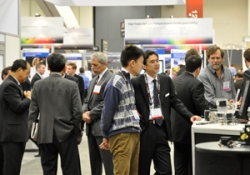Feb 4 2010
SPIE Photonics West completed its debut week at the Moscone Center in San Francisco Thursday with the final attendance count at 18,327, a record for the event.
The new venue was a hit with attendees, and provided welcome room for growth. Both the Photonics West exhibition, with 1,142 exhibiting companies, and the BiOS exhibition, with 178, were larger than in past years.
 Visitors at SPIE Photonics West
Visitors at SPIE Photonics West
Technical and exhibit attendance were up, and attendees said the event provided indicators of strength in the biomedical optics and photonics sectors of the economy. Conference chairs reported seeing high-energy discussions and high-quality presentations in the technical sessions where some 3,600 papers were given, and poster receptions were well-attended, with 2,200 attendees at the BiOS session. Course attendance was also high in the more than 60 presented on optoelectronics, photonics applications, and professional development.
"I am absolutely impressed by the number of people who are here and the quality of questions people ask when they come to the booth," said Kumar Patel, inventor of the carbon dioxide laser and founder of Pranalytica. "To see this many people out at a trade show or at a conference is so satisfying. I hope that's an indication of how things are going to be in the coming year and sometime thereafter."
Technical highlights included a well-attended BiOS Hot Topics session highlighting new cancer therapies, intravascular diagnostics, imaging techniques, and other advances in biomedical technology. Industry expert panels gave perspectives on photonics markets in silicon photonics, solar, optics, and lasers.
Among the well-attended plenary talks were an OPTO symposium talk before a packed hall by LED pioneer Shuji Nakamura (Univ. of California, Santa Barbara) on recent developments in blue and green laser diodes; a LASE talk by Andreas Tünnermann (Friedrich-Schiller-Univ. Jena and Fraunhofer Institute for Applied Optics and Precision Engineering) on prospects for ultrafast lasers for manufacturing and other technologies; and a talk by Wilfried Mokwa (RWTH Aachen Univ.) on use of MEMS technologies in the development of artificial retinas to restore vision.
Among presenters of several best-paper awards was Charles Townes, who won the Nobel Prize for Physics in 1964 for his work on the optical maser.
Laser anniversary
The laser was celebrated on its golden anniversary throughout the week. In the Photonics West exhibition hall, an extensive display of vintage laser gear included an original laser made by Theodore Maiman, inventor of the first laser, and nearly 100 other pieces. Tribute videos and photographs inside and at the entrance to the exhibition hall showcased laser legends and luminaries. A memorable party at the "Cirque du Lasaire" welcome reception was enjoyed by 2,400 attendees who were entertained by a laser light show, laser magic, acrobats, and videos showcasing lasers in popular culture as well as technology applications.
SPIE is celebrating the laser anniversary in 2010 through the Advancing the Laser campaign, supported at Photonics West by Biophotonic Solutions, DILAS, Edmund Optics, HellmaOptik, CVI Melles Griot, Newport, New Focus, NUFERN, OptoSigma, Spectra-Physics, Toptica Photonics, TRUMPF, and Laser Focus World, and as a Founding Partner and Sponsor of LaserFest, a collaborative celebration of the science community.
Winners of the 2009 Prism Awards for Photonics Innovation, cosponsored by SPIE and Laurin Publishing, were named at a mid-week banquet. A complete list of the winners and the innovations is on the Prism Awards website website.
The National Ignition Facility (NIF) at Lawrence Livermore National Laboratory hosted a tour for approximately 120 Photonics West attendees on the final day of the event. The NIF is the world's largest laser system, with 192 laser beams housed in a 10-story building. Experiments aimed at achieving ignition creating an energy gain envisioned as a future energy source are expected to begin later this year.
Conference proceedings are published in the SPIE Digital Library individually as soon as approved after the meeting, and also in collected print and digital volumes and collections.